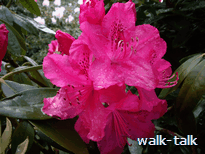

home | books | treeblog | talks | walk of the month | walk directory | contact us
Ancient woodland, interesting houses, a magnificent drive way,
working countryside and long views make this walk a gem. It is close in to the centre of St Albans city
but with lots of parking for which there is no charge.
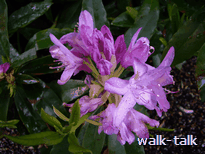
The walk displayed here on the walk-talk Website has lots of photos and comment (in italics) as well as directions (in bold) so that you can take a virtual walk - you can enjoy imagining the walk.
To do the walk in reality, use the print options below to give yourself the combination of direction detail, map and/or information that suits you.
The documents are in MS Word format so that you can add your own notes and delete what you do not want.
To print, click: short directions | map | full directions with map and photos | comments and info
The Golf and Tennis Centre has a café where you can get a hot or cold drink and a sandwich and either sit at a table inside or on a bench outside to enjoy it.
The walk circuits historic Batchwood Hall,
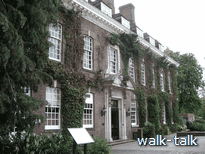
meanders through the home wood
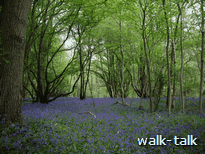 and then across the golf course into Batch Wood,
and then across the golf course into Batch Wood,
across a field and through a fruit farm and into
Childwickbury drive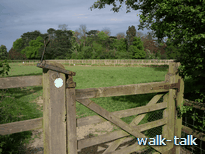
along
the rhododendron-lined drive
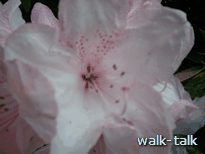
by St Mary’s church
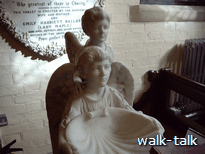
to the
manor where Stanley Kubrick lived 
and back
by Childwickbury Goat Farm
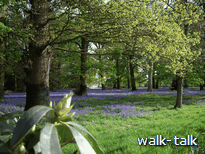
and Lady Grove
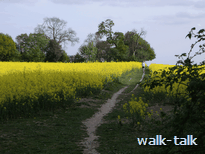 with
good long views.
with
good long views.
The start is at Batchwood Hall, Batchwood Drive, St Albans, AL2 5XA. NGR: TL 137088.
To get there from St Peters Street in St Albans, leave the Town Hall behind you, cross the Catherine Street/Hatfield Road roundabout and keep on into Harpenden Road. At the traffic lights, turn left into Batchwood Drive and, immediately after the first road to the right (Green Lane), turn into Batchwood golf course. It is well signed at the entrance.

This mapping data licensed from Ordnance Survey® © Crown copyright 2007.
All rights reserved, licence number 100046670.
Start at Batchwood lower car park, denoted by the open red circle.
Follow the red arrows.
BRIEF DIRECTIONS
Walk across the front of Batchwood Hall.
Turn left at the end of the Hall, and left across the back of the Hall.
Go right along the asphalt path at the end.
Go left at the end (opposite the ha-ha on the right), taking the path that has yellow-and-black striped stays coming down on to its right.
Cross over the road and continue on the path opposite.
Follow the path keeping the golf course on your right until you come to an avenue of maples on the right of the car park.
Continue up the maple avenue and to the left of the tall protective netting.
Cross the fairway at the tall conifers.
Go into the woods and turn right along the path keeping the golf course on the left.
At the bottom of the hill, follow the footpath waymark left.
At the next waymark, go right until you come to open fields.
Either go out into the open fields and go right until you meet the hedge on the far side or go right through the woods, out at the end and on towards the hedge on the far side.
Go left along the hedge to the far corner where follow the bridleway waymark under trees and to the right.
Come out through a gate into a fruit farm.
Go ahead and to the right then left in front of the trees through the fruit farm.
Go out into Harpenden Road and turn left.
At the red brick and yellow stone lodge, go through the wrought iron gates into the drive between banks of rhododendrons.
At the crossroads, go left in front of the church.
Continue on leaving the lodge on your right and then the Manor House on your left.
At the arched gate and the sign for Childwickbury Goat Farm, keep straight on along the tunnelled path.
Cross the field and keep to the right of the line of trees ahead.
The path curves left and comes out on to the drive within Batchwood.
Go left up the avenue until you see the Hall on the right.
Take the golfers’ path towards the Hall.
Pass the side of the Hall out on to the road.
Go right in front of the Hall back to the car park.
FULL DESCRIPTION
Having parked in the first car park we come to as
we come up the drive into Batchwood, we walk on up the hill and come to
Batchwood Hall, an
imposing deep-brown brick building on the left hand side.

Batchwood Hall
TL137088
Batchwood Hall, home of Lord Grimthorpe, saviour or desecrator of the Abbey fabric, depending on your view. He acquired the land from the Gorhambury estate, of which more later and built the house. It is a nightclub now, refurbished after a fire a year or two after the millennium in cool blues and greys. There are separate spaces for different kinds of dancing and for sitting to talk, for eating and drinking and so on.

Look up at the clock turret on the near side of the Hall.
Clock turret
TL 137088
Lord Grimthorpe, then E D Dennison designed the clock that we call Big Ben (strictly the name of the bell) and ought to call the Westminster Clock. The clock in the turret was also designed by Lord Grimthorpe and is regulated by his famous Dennison escapement. The clock was repaired for the millennium.
You can read about the clocks and about Lord Grimthorpe and the estate on the boards in front of the house.
We continue in front of the Hall and come level with curved yew hedges on the right leading up to brick posts with stone balls on top.
This is the entrance to the Batchwood Golf and
Tennis Centre where we can get refreshments.
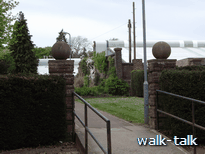
Posts with stone balls
TL 137088
The high brick wall we see to the right of the path to the Centre is the remains of a walled garden. The herbaceous border between it and the path is a picture at different times of the year: bulb flowers in spring, poppies and hollyhocks, climbing roses and lilies in summer. There are some impressive wrought iron gates in it above graceful rounded steps.
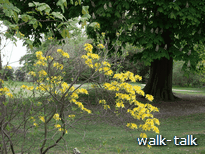
We go left at the far end of Batchwood Hall.
There are rhododendrons on the drive and, if we are early enough, a golden azalea is on our right as we turn with the nightclub barbeque area on our left.
Azaleas at the side of Batchwood Hall
TL137088
The putting green is ahead and we go left under a Holm oak (a holly oak) in front of the Hall.
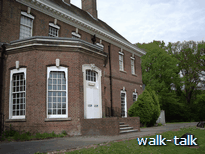 There
are rose beds and the putting green on our right. If we go up on to the steps of
the Hall we can see the excellent view of the Abbey that Lord Grimthorpe had.
There
are rose beds and the putting green on our right. If we go up on to the steps of
the Hall we can see the excellent view of the Abbey that Lord Grimthorpe had.
Steps of the Hall
TL137088
Lord Grimthorpe is reputed to have had a telescope so that he could keep an eye on the men working on the roof and on the west face of the Abbey.
To the right and on the far side of the putting
green is a small wooden building.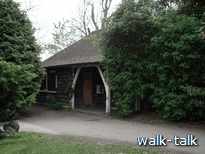
It
is clad in elm planks, great thick beautiful ones, perhaps the last we shall
ever have. 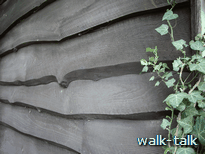
Elm plank cladding
TL137088
At the end of our path we go right, by two tall spreading oaks.

On
our left is a bank of mauve rhododendrons.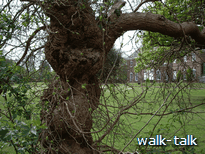
The next tree on our right is a mulberry, a white mulberry, the kind whose leaves are the food of silk worms. If it is mulberry time, be respectful of the fruit: it stains irrevocably. The trunk is grossly burred.
Mulberry tree
TL137088
Beyond the mulberry, and in line with it and the two oaks, is a holly tree
and to the right of that, in good view from the main windows of the Hall, is a London plain sapling that was planted to commemorate the hundred years since the death of Lord Grimthorpe.
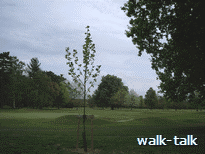 The London plain sapling
The London plain sapling
planted for Lord Grimthorpe’s centenary
TL137088
The tree named for London and so closely associated with the capital, keeps us in mind of the Westminster clock and its escapement that he designed.
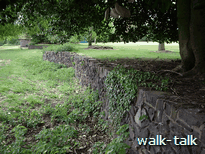
The tree is on the edge of a ha-ha, which protected the gardens from animals without spoiling the view from the house.
The ha-ha
TL137088
As we draw level with the ha-ha, we go left, still on asphalt, although the asphalt peters out soon. We go slightly right on to a path with two yellow-and-black-clad stays coming down to the right of it.
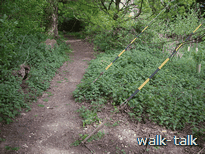
Yellow-and-black-clad stays
TL138088
We ignore the entrance to the composting area on the left.
We have new planting on our right. It looks
like hazel. We are following a line of proud oaks on the left of our path. If we
look up to the left we can see that there is more new planting. The area is open
because some huge trees, amongst them an ash, fell blown over by storms and old
age and that let the light in and made it possible for a whole new range of
flora and fauna to thrive. 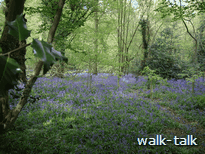
This pathway and the new planting has been done by the Friends of Batchwood who manage the precious ancient woodland, create these lovely paths for us and create places for us to rest and absorb the tranquillity and beauty. They welcome support, both practical and financial. If you would like to support them, the person to contact is Miles Soppett, Friends of Batchwood, c/o Batchwood Golf and Tennis Centre, Batchwood Drive, AL3 5XA.
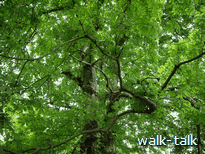 Tranquillity
and beauty
Tranquillity
and beauty
of Batchwood home woods
TL138089
We go under a wonderful horse chestnut tree.
Horse chestnut tree
TL138089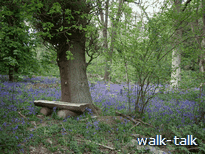
We cross an open space of cut
grass with a golf driving range to the right. To the left is a glade with a log
bench, a special place to sit in bluebell time.
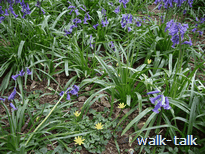
Log bench
TL138089
There are bright yellow celandines in amongst the bluebells and just a few wood anemones along the path.
Celandines in amongst the bluebells
TL138089
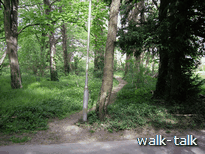
We cross the drive leading up to the Hall and Golf and Tennis Centre and carry on along the path opposite, which curves up hill and to the left.
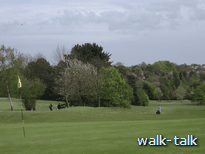 The
path across the drive
The
path across the drive
TL140089
The golf course is close on our right. We are going behind a green and the golfers might well be striking from beneath our horizon so be wary.
The golf course on our right
TL140090
Take time to look at the view over St Albans. The houses bank steeply upwards and we can see St Peter’s church tower above all.
Immediately after the golfing green, there are
baskets round the tree stumps (stools) to protect the new shoots from deer and
rabbits. The baskets are excellently
made, in the tradition used for millennia to protect the stools after coppicing.
There is a path alongside the baskets but we
ignore that and carry on.
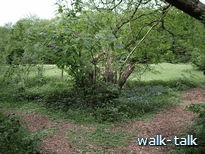
Soon the path divides and we want to go left.
Where the path divides, we go left
TL140090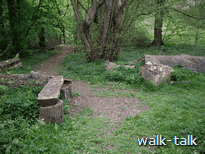
It is tempting to go straight on across the golf course but it is dodgy. There is no right of way and there is a dogleg in this fairway, which makes it unsafe. Soon there are logs to our left and right and the golf course is on our right.
Logs to the left and right of our path
TL140090
We go down hill and can see the huge hollow in
the fairway where Lord Grimthorpe dug clay for bricks. It is a favourite place
for tobogganing in snow. On the day I am walking, however, it is bluebell time
and the deep mauve is so dense that it shimmers and moves playing the tricks of
op art or a mirage.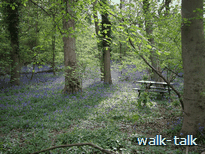
At the bottom of the hill, note the picnic bench in the woods. Apart from seeing that we are at the bottom of the hill, this will be our marker we can use when we are on the far side of the golf course, confirming that it is time there to take a turning.
Picnic bench
TL139090
We continue on, up hill.
There is mostly oak and a bit of coppiced hazel on our
left. Note the piles of brash, evidence of the work of the Friends of Batchwood.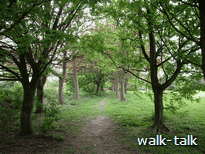
We come up with the corner of the car park on our left, the golf course still on our right and, ahead of us, an avenue of maples, which we go on under. In April, the tiny yellow balls of pollen that are the maple flowers, carpet our path.
Avenue of maples
TL 139090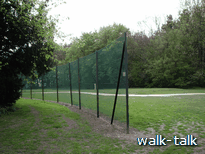
At the end of the avenue, we bear right, staying close to the trees and keeping clear of the golf course until we can be on the left of the high netting that will protect us from the golf balls.
We go left of the protective netting
TL 138090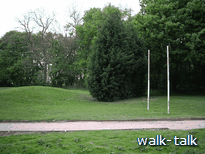
We join a golfers’ path and we go right by the line of tall conifers.
Line of conifers
TL 137090
Over our left shoulders we can see the golf and tennis centre, with the gym in the bit furthest from us. There used to be a bar above the gym and you can see what a smashing view it had. It is still available for golf society functions and parties but the café by reception is now the place open daily for light refreshment.
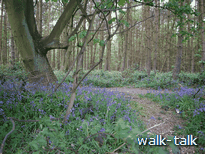
We go on into the woods ahead. If we look left we can see the light at the end of the woodland. The field beyond is the one we shall cross as we return from Childwickbury. We go RIGHT, along the clear wide path, the golf course now on our right, conifer woods on our left.
We go into the woods and turn right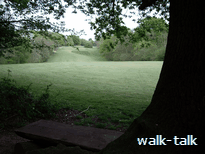
TL 137091
The golf course is on our right
TL 138091
Note how little grows beneath conifers. There are scrubby brambles and that is about all. Note that there is the occasional standard oak left amongst the pines. I suppose the foresters felt that they would eventually be of value even if not in the time they hoped to get their return from the pines.
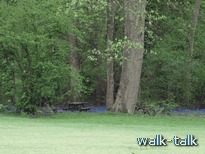
We ignore paths to the left until we get to the bottom of the hill opposite where we saw – and can still see – the picnic bench in the woods on the other side of the golf course.
Picnic bench on the far side of the golf course
Seen from TL139091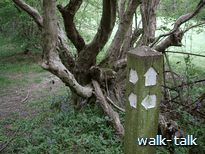
On our side, there is a waymark post with white arrows, one of which points left and that is the one we follow.
We follow the white arrow pointing left
TL 139091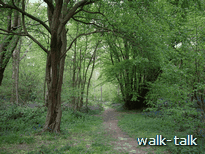
The scene as we turn left
TL 139091
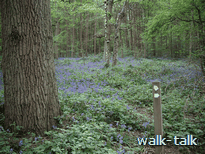
We hold our direction until we come to another waymark post. One arrow points diagonally up and to the left but we want to follow the direction of the arrow pointing right.
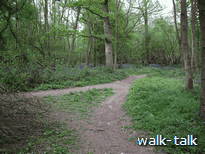
We follow the arrow pointing right
TL 139093
There are magical open glades along this stretch, especially on our right.
We pass a pair
of rusting wheels on an axel. They are on our right. Ignore the path in that
direction.
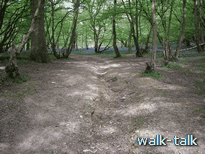
Our path has a deep gully in the middle of it, worn by water streaming down it after rain.
Deep gully in our path
TL 139093
There are interesting wood banks on the left. There is known to have been at least one mediaeval dwelling in this part of the wood. Batchwood was part of the Childwickbury estate in Saxon times. It has its name from the Bachesworth family who owned it at the close of the thirteenth century.
The hornbeams in the woods here each have multiple trunks, showing that they were coppiced at one time but a long time ago because they are huge trees now.
I can hear a woodpecker
knocking. 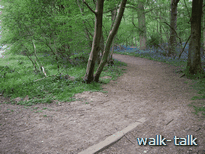
We come to a spaghetti junction of paths. We can see open space with football posts ahead and, if we feel we would like to be in the open we can go out into the field and make our way, zigzagging round the football pitches, to the far diagonal corner of the field, ahead and to the right. On the other hand, we can take advantage of the shade of the woodland and continue just within it, keeping the field within sight on the left.
Continuing just within the wood,
with the field on the left
TL 140099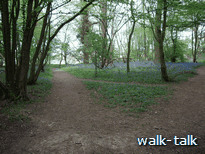
As we continue, the woodland bulges out into the field a bit so that the edge gets a bit further from the path but we keep left rather than right until we are out into the field further on.
We keep left rather than right
TL 141099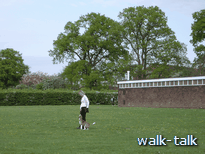
The houses along Toulmin Drive are on our right and the football changing rooms are ahead of us. They are in a single-storey building of dark brown brick with a shallow row of white-framed windows under the roofline. The Saturday and Sunday league footballers use these playing fields.
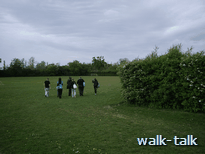 The
changing rooms
The
changing rooms
and the hedge beyond
TL 142096
We make for the hedge beyond the changing rooms, leaving them on our right. We zigzag to avoid the pitches. When we reach the hedge we follow if left (so that it is on our right). Townsend School is on our right over the hedge.
We follow the hedge left
TL 142097
In the corner of the field we see a blue bridleway waymark on a post. We follow the direction of its arrow to the right.
The corner of the field and its blue bridleway waymark
TL 142098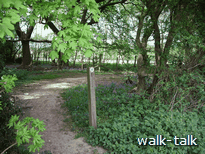
We have a silver-birch copse
on our left and we are confined on a good clear path between fences. We can see
the playing fields of the School on our right and beyond that the school
buildings.
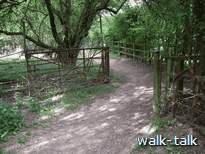
The path wiggles at a gate that looks as if it is permanently open.
A wiggle in the path at a gate
TL 143099
The bluebells on the left
are stunning. I did not think I would say so after the magnificence of the ones
in Batchwood but here they are. Lying by the path are some interesting logs from
a double-trunked tree. There is a dense hawthorn hedge on the right and we get
brief glimpses of a paddock behind it.
it.
We come out at a gate with a distinctive heavy metal square closer.
Gate with a heavy closer
TL 143100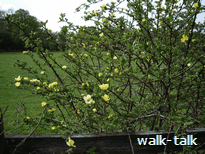
There is a lovely yellow rose-like flower on a couple of shrubs by the fence.
Shrubs on the left through the gate
TL143100
The bridleway waymark arrow
points diagonally right and the path goes straight ahead for a bit and then
bears right between fruit planting.
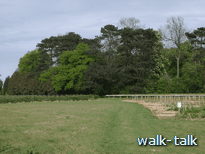
Path through the fruit farm
TL 143101
We are in a fruit farm that has pick-your-own in late summer. Strawberries on high, irrigated channels are on our right and raspberries and then currents on our left.
The bank of trees ahead of us is most attractive.
There is a towering horse chestnut with an even taller solitary ash tree to its
right. Close to the horse chestnut are pines and on its left is and oak, its
foliage cascading down. Away to the right, behind the strawberries there is a
copper beech and away over our right shoulders we see slate roofs and more
copper-coloured trees.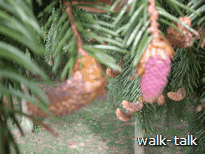
As we get close we see that the cones on the pines have fascinating shapes and colours: the one lot buff coloured and as perkily curved as a cashew nut, the others the shape of a tiny spinning top, a mass of pale crimson spores that disperse in a cloud as they are disturbed.
Cones on the conifers
to the right of the path
TL 143101
Beneath one of the rows of fruit plants on the left is a sign “Ben Connan”. Is that the name of a particular berry?
The pick-your-own shed is
soon on our right and then the farm house and outhouses. The sign says Hawkswick
Lodge Farm.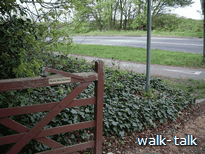
We come out on to Harpenden Road and go left along a pedestrian and cycle path.
Gate on to Harpenden Road
TL 147105
I wish I could say keep an
ear alert for cycles cut the noise of the cars on the road makes that futile.
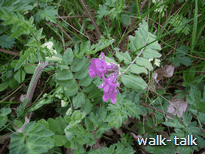 All
you can do is keep a steady and straight course to one side or the other. The
good news is that there is this path and that we do not have to go along it for
long – and there are brave meadow flowers on the verge.
All
you can do is keep a steady and straight course to one side or the other. The
good news is that there is this path and that we do not have to go along it for
long – and there are brave meadow flowers on the verge.
Wild flowers on the verge
TL 145106
The fruit farm and then a
wide paddock are on our left. On the far side of the road is Cheapside Farm with
the railway line just to be seen almost on the horizon beyond it.
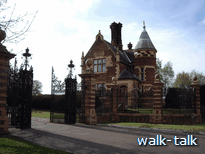
Soon on the left we come to the amazing late Victoriana red brick and yellow stone lodge and gateposts at the entrance to Childwick.
Lodge and gate to Childwick
TL 145107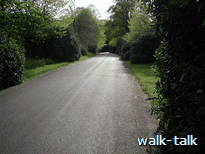
We go through the splendid wrought iron gates and between the astounding banks of rhododendrons that flower in late May and June.
Childwickbury drive
TL 147102

There seems to be every colour and marking and size of flower, each one a piece of perfection, blousy and open and voluptuous.
I adore
rhododendrons. I think they are a sensuous beautiful flower.

Rhododendrons along the drive
TL 147102
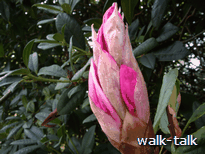 However,
in the wild in Britain they are designated an “invasive non-native species”
because they threaten the more delicate native flora and fauna. James Kirkup and
Ian Johnson in The Scotsman on 10 March 2007, quoted Richard
Luxmoor of the National Trust for Scotland, whose volunteers have been battling
the fast-growing invaders at Scottish sites, including for several years:
"As soon as you get rhododendrons in there,
they shut out all the light out and kill all the mosses on the floor of the wood
and on the trunks of the trees." They were referring in particular of Coille
Mhor, near Kyle of Lochalsh, where there are “mosses and lichens that grow
nowhere else in the world can be seen on the forest floor and the trunks of the
trees,
However,
in the wild in Britain they are designated an “invasive non-native species”
because they threaten the more delicate native flora and fauna. James Kirkup and
Ian Johnson in The Scotsman on 10 March 2007, quoted Richard
Luxmoor of the National Trust for Scotland, whose volunteers have been battling
the fast-growing invaders at Scottish sites, including for several years:
"As soon as you get rhododendrons in there,
they shut out all the light out and kill all the mosses on the floor of the wood
and on the trunks of the trees." They were referring in particular of Coille
Mhor, near Kyle of Lochalsh, where there are “mosses and lichens that grow
nowhere else in the world can be seen on the forest floor and the trunks of the
trees,
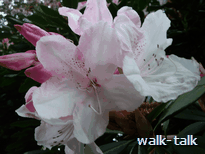 creating
a local environment so distinctive it is officially designated a site of special
scientific interest (SSSI).”
creating
a local environment so distinctive it is officially designated a site of special
scientific interest (SSSI).”
This sounds unpalatably true and I remember hearing when Anthony Hopkins made substantial donations “to save Snowden for the nation”, rhododendron clearance was one of the tasks that the money would go towards. However, on the BBC Website plant profiles, it says that “The only areas where rhododendrons don't occur in the wild are Africa and South America.” I wonder what the British wild ones look like and whether they are as threatening to other local species as the ones introduced from abroad.
The BBC quotation is also
interesting in that Kirkup and Johnson state that rhododendrons were introduced
from Africa. I suppose that if the BBC is right and they are not native to
Africa, they could have come to Britain via Africa.
 This
sounds unlikely, because the BBC profile states that rhododendrons have been
here since the 18th Century “although not wide spread until the 1900s.
This
sounds unlikely, because the BBC profile states that rhododendrons have been
here since the 18th Century “although not wide spread until the 1900s.
I associate banks of rhododendrons with the kind of homes in which Agatha Christie set her detective stories: weekend parties with guests coming up the rhododendron-lined drive to meet their hosts and fellow guests, one of whom you can bet would be bumped off by evening.
In some countries
rhododendrons grow into huge trees with leaves a yard long (from the tip of your
fingers to the tip of your turned-away nose).
of your turned-away nose).
The dwarf hybrids are called
yaks, not because they come from the heights of the Himalayas where they and
yaks thrive on the rare atmosphere, but because they are bred from the dwarf
species R. yakushimanum. The word has
a lovely sound and it would be
interesting to know its origin, but I like, too, other more obviously
descriptive names:
 pink
pearl, bashful (a dwarf variety?),
morning magic, gold dust.
pink
pearl, bashful (a dwarf variety?),
morning magic, gold dust.
We could try matching the names to the flowers we see in Childwickbury drive – or make up names for them. I think I have spotted gold dust and I shall name one of them freckles and another lady’s boudoir.
By the way, remember to “dig in plenty of organic matter, such as well-rotted manure” before planting: rhododendrons like a low pH.
The message for us townies has to be: keep rhododendrons confined to gardens and do not think you would be doing everyone a favour by planting the lovely things in a woodland.
The drive is also a picture
of flowers at daffodil time and at bluebell time – and at any time is a picture
of dark green foliage backed by beautiful British trees - and the views between
the rhododendrons are picturesque: on the right, grey-green leafed trees,
maroon-leafed trees, jaunty chimneys, paddocks and horseboxes and old rooftops;
on the left dun, tawny and black-and-white cows that stare curiously at us from
a wide meadow with woodland beyond.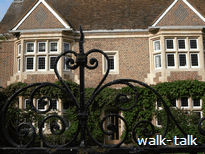
The drive turns right and then we come to a lovely Jacobean-style house clad with wisteria.
Jacobean house at the top of the drive
TL 142108
There is usually a charity garden open day in early summer. It is a treat.
We turn left, leaving the church on our right.
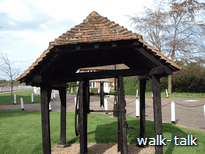 In
front of the church is a shelter over a wheel and more of a mechanism. Was it a
shelter over a well, and this the wheel for the windlass? Tacked to the woodwork
is a small plaque that says “Hertfordshire best kept village competition 1975
Special award”.
In
front of the church is a shelter over a wheel and more of a mechanism. Was it a
shelter over a well, and this the wheel for the windlass? Tacked to the woodwork
is a small plaque that says “Hertfordshire best kept village competition 1975
Special award”. 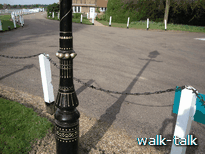
Shelter over a wheel
TL 141108
Note the
black and gold, no less, detail on the lamppost at the corner and the super
copper beech tree at the top of the drive and now in front of the church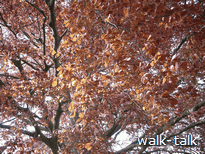 .
.
Lamp post and copper beech by the church
TL 141108

St Mary’s church
 TL
141108
TL
141108
The church is St Mary’s and was designed by George Gilbert Scott and built in 1867 by the Toulmin family. We passed by Toulmin Drive as we came out of Batch Wood on to the football fields, you might remember.
When the
Toulmins found that their tenants were loath to walk all the way to St Michaels
on a Sunday, he called their bluff and took away their excuse by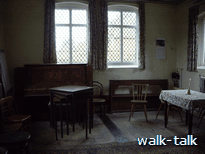 building a church on the Green.
building a church on the Green.
They built also an adjoining schoolroom and Henry Joseph Toulmin and his wife Emma (or Emily) taught their tenants, many of them elderly, to read and write.
The schoolroom
adjoining St Mary’s church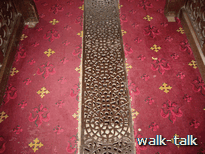
The darker line down the middle of the floor is a heating duct in decorative metal. It is in the church, too.
Decorated heating duct in St Mary’s
I owe much of this information, and the information below about the church and Childwick to the leaflet to be found in the church.
The leaflet welcomes EVERYONE, underlined and in caps, to the evening services held every Sunday at 6pm. There is holy communion at the evening service on the first Sunday of the month. I think you should risk it: the interior of the church is a treat.
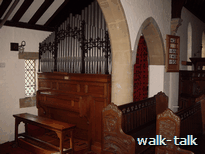
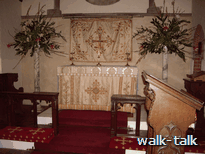
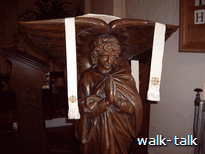
Inside St Mary’s
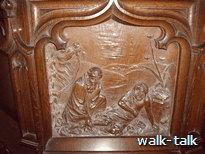
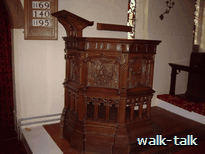
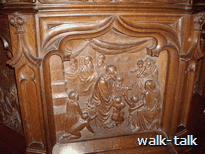
The Faith Hope and Charity windows in the Chancel are in memory of Henry and Emma Toulmin, as are some gates at St Michael’s church and a window in the Abbey.
It was Henry Joseph’s father, Henry Hayman Toulmin, who bought the Childwickbury estate in either 1851 or 1854 (each date is quoted). He was a shipowner.
Henry Joseph and Emma lived at Childwickbury with his parents when they were first married. Then they moved to the Pre which they rented from the Earl of Verulam, the Pre being the dower house of the Gorhambury estate. After Henry Joseph’s father died they moved back into Childwickbury for a while but then, in 1881, sold the big estate and returned to the Pre. We shall pass above the Pre towards the end of our walk.
It was to
Sir
John Blundell Maple that HJ Toulmin sold the Childwickbury estate in 1881. Sir
John’s father John Maple had owned a small furniture shop in Tottenham Court
Road. The rest is history: the son was an imaginative business man and the firm
became global players, importers of timber and manufacturers and exporters of
furniture. Maples “furnished palaces all over the world, including Tsar
Nicholas's Winter Palace, the Hofburg Imperial Palace in Vienna, all the great
hotels, and town and country homes. Prestigious British embassies were all
furnished by Maples, even if it meant carrying the grand piano up the Khyber
Pass on packhorses.”

Sir John enlarged the church and the schoolroom, which was used as a school until 1925, and then again for evacuees during the second world war.
Two Sir John’s daughters died of scarlet fever. They were very young and it must have been heart rending to lose them, in successive years. In their memory, Sir John commissioned and donated the exquisite marble font in the church. The faces of the angels that support the shell font are not stylised or pretty and I think the angels must be likenesses of the girls.
St Mary’s font commemorating the Maple sisters
It is a lovely
memorial – and a very special font. Not only the font and a plaque on the wall
behind the font commemorate the girls: Sir John had recognised the need for an
infectious diseases hospital and had one built in St Albans. He called it The
Sisters Hospital.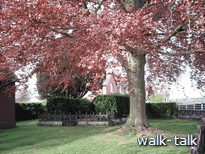
The Maple vault is in the churchyard behind hedges and a wrought iron fence and, according to the church leaflet, “contains the coffins of Sir John and Lady Maple and their three daughters”. I have found reference “His only surviving daughter married Baron von Eckhardstein, of the German Embassy, in 1896.” I do not know whether this is the third daughter buried in the vault or whether there was a fourth daughter.
The Maple vault in St Mary’s churchyard.
Sir John left the estate to his widow and she “allowed the people of St Michael’s and St Mary’s to make the Church their own for a nominal sum”. I love the wording. The leaflet says that this was “to ensure that it would always belong to them”.
It was Sir
John Maple who had founded the stud on the estate but it is Jack Joel, who
bought the estate at auction in either 1906 or 1907 (according to the leaflet)
who is more famous for his horse breeding. Jack and his brother Solomon Barnato
Joel “had made their fortune helping their uncle, Barney Barnato, in South
Africa. Barnato had helped found the DeBeers Consolidated Mines in partnership
with Cecil Rhodes. Later, Barnato made an additional fortune in gold mining. The
brothers invested in their uncle's financial empire, and enjoyed a considerable
inheritance when their uncle died by suicide in 1897. Solly and Jack
Joel returned to England, where the former
founded Maiden Erlegh Stud, and the latter Childwick Bury.”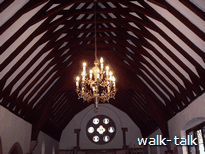
The church leaflet tells us that Jack’s son H J Joel, known as Jim Joel, inherited the estate from his father in 1940 and “made many generous gifts to the church including the chandeliers and the marble pillars in the chancel”.
One of St
Mary’s chandeliers donated by HJ Joel

There is a small collection of photographs on the wall of the schoolroom.
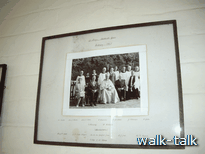 One
of them is a gathering in 1967 and is labelled “Centenary Celebrations”,
confirming that the church was built (by the Toulmins) in 1867.
One
of them is a gathering in 1967 and is labelled “Centenary Celebrations”,
confirming that the church was built (by the Toulmins) in 1867.
The photograph shows the bishop in the centre with the mayor and then the mayor’s wife on one side of him and Jim Joel seated on the other side of him. Standing immediately behind and between the bishop and Mr Joel is the church warden, Edwin May, who was a chorister and also butler to Mr Joel. Behind and around the church warden are other members of the choir, which is no longer in existence.
Photos in the schoolroom
The Maundy Money which is in the wall at the back of the choir stalls was given to Edwin May by the Queen when she distributed the Royal Maundy in St Albans Abbey in 1957. Edwin May bequeathed the Maundy Money to the Church.
The Women’s Institute uses the schoolroom regularly and so do a stamp collecting group and the women’s graduate. The room and tea and coffee making facilities are available for hire at a nominal rate.
In 1978 the estate was divided and sold. The Marquesa de Moratella bought the stud farm and Stanley Kubrick, the film director, bought the manor house. Films directed by Kubrick include Spartacus (1960), Lolita (1962), Dr Stangelove (1964), A Space Odyssey 2001 (1968) Clockwork Orange (1971). Eyes Wide Shut with Tom Cruise and Nicole Kidman was his last film. Kubrick died of a heart attack only days after screening a final cut. He was 70. It is said that he is buried in Childwickbury next to) his favourite tree.
Kubrick’s widow Christiane Kubrick lives at the Manor. She hosts the prestigious Childwickbury Arts Festival each summer. There are exciting music concerts, we can make and glaze pots in one of the manor outhouses, all kinds of works of art are on display, we are invited to display our art and participate in other ways, and the stables are open for refreshments. This year, 2007, the Fair is on the 6th, 7th and 8th July. To find out more go to http://www.childwickbury-arts-fair.com/.
We continue on the road leaving the church and the green on our right.
The substantial
attractive houses on the edge of the green were built about the turn of the last
century - towards the end of the time of the Maples’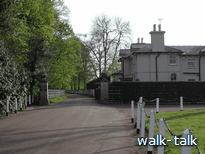 ownership. It is known that workers cottages were pulled down about or before
this time. It is thought that they would have been where the green is now.
ownership. It is known that workers cottages were pulled down about or before
this time. It is thought that they would have been where the green is now.
Ahead is the Manor lodge. In his time, this was the home of Edwin May.
The green with the Manor Lodge beyond
TL 140106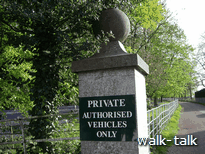
We go to the left of the lodge, undeterred by the sign that says that this is a private road for vehicles. It is a public bridleway.
One of the posts to the left of Manor Lodge
TL 140106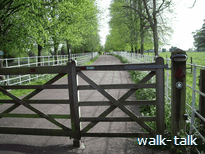
We come to a security gate across the road and there is a small gate at the side with a waymark and “Push” on it. That is what we do: push, and go through it.
A security gate
TL 140106
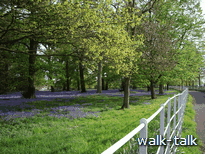 There
is a field of oaks on our left with bluebells beneath.
There
is a field of oaks on our left with bluebells beneath.
Oaks and bluebells to the left of Childwickbury drive
TL140105
Ahead and to
our left are attractive brick stables and outhouses with pretty roofs. We are
walking up an avenue of lime trees. There is open parkland on the right with
some beautiful spreading trees.
We come up to the manor house on our left. The gates have gold-painted feather-like leaf decorations as well as the usual tight curly bits.
The gate to Childwickbury Manor
TL 139104
 To
me, what is distinctive about the house in its current form is the little
pillars along the top, rather like
banisters so that the roof area has the look of a landing in a substantial
middle class home of the kind where one expects children to be kneeling in their
pyjamas peering through the pillars (banisters) at the grown up party below.
To
me, what is distinctive about the house in its current form is the little
pillars along the top, rather like
banisters so that the roof area has the look of a landing in a substantial
middle class home of the kind where one expects children to be kneeling in their
pyjamas peering through the pillars (banisters) at the grown up party below.
Childwickbury Manor House
TL140103
Childwickbury was given to the abbot and monks of St. Albans Abbey by Ailwin Niger and Ailfleda his wife at the instigation of King Ethelred II, in the later part of the tenth century. Good names. And what sort of 'instigation' was it that had a give away a huge estate? That was in the 900s, more than a century before the conquest.
The land was taken back by William Rufus then given back to the Abbey then seized in 1290 by the king's ‘escheator’ (an intriguing word: what he do?) and that seems to have set a pattern of Mugabe-worthy ‘appropriations’ and ‘assignments’ and ‘seizings’ of the manor by kings and abbots, the income from it being variously allocated to the ‘maintenance of the prior and convent’, the ‘anniversary of an [particular] abbot’s soul’, then to ‘the provision of bread for the monastery’, then back to the prior and convent, then for the ‘improvement of the bread and ale of the monastery, later to ‘provide one loaf and two herrings each for 300 poor persons at the feast of All Souls, for the souls of Pope Boniface VIII and Abbot Roger de Norton’. On that last occasion the abbot ‘reserved to himself homage, wards, marriages, reliefs, &c., belonging to the manor, and view of frankpledge there’ whatever f'rankpledge' was and how one 'viewed' it.
The church leaflet has a captivating statement on the relationship between the manor and the Abbey: ‘The monks then learned a vocation and supplied the Abbey with milk – hence the name Child wick or young people’s dairy farm.’ Were the monks particularly young? Does wick mean dairy farm? Chambers' dictionary adds 'farm' to 'settlement or village' under wick but not a hint of cows.
After the dissolution of the monasteries by Henry VIII, the estate passed into private hands and was bought in 1666 by Joshua Lomax, a man from Bolton, Lancs. Lomax built the house that we see and the Lomax family lived in it for 200 years, selling it on to Henry Toulmin.
We continue along the asphalt road we are on.
This is a long stretch with, on the right, pleasing parkland in the foreground and then a long view over fields, some of them golden yellow with rape seed flowers, delineated by dark green hedges, punctuated by pylons and telephone masts and backed by woodland. We are looking across the Ver valley with Redbourn Road close to the river here. To the left there is open pasture and the occasional oak, with pines beyond. Even the metal fencing denotes order.
When we come to a carved
wooden sign to mark the entrance to the Childwickbury Goat Farm on our left.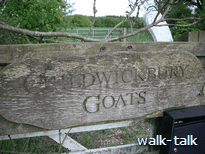
Entrance to the Childwickbury Goat Farm
TL 135095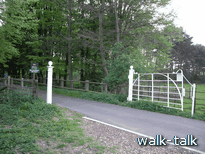
and an arched metal gate, usually open, a bit to our right,
Arched metal gate, usually open
TL 135095
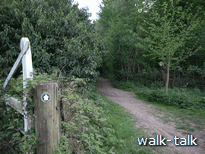 we
want to go absolutely straight ahead down a path tunnelled by over-reaching
trees.
we
want to go absolutely straight ahead down a path tunnelled by over-reaching
trees.
Our path,
tunnelled by overhanging trees
TL 135095
Through the hedge between us and the Goats Farm, we get glimpses of small wooden shelters. The farm sells its superb soft goats cheese on the St Albans market, along with an exceptional range of interesting cheeses. The farm keeps bees as well as goats.
Small birds dip across the path here.
Ladiesgrove Wood is ahead and to our right, Batchwood ahead and to our left.
Our path comes out at a field and we carry straight on through it. The path is always clear even when crops are planted. This route is well trodden and well cycled.
Up the hill on the other side of the valley, the Ver Valley, on our right must have come Boudicca’s followers fresh from the sacking of Verulamium. Or so we assume for “signs of burning have been found dating from the time at the well-to-do farmstead at Gorhambury” (Rosalind Niblett, 1995, Roman Hertfordshire”). Ms Niblett goes on to say that “recovery after the revolt seems to have been rather slow…the farmstead at Gorhambury.., which had been a thriving concern in the 50s, was reduced by the late 60s to a number of simple round huts.” (ibid). I like Ms Niblett referring to "the 50s and 60s" in just the familiar way we do of our own closer decades nearly two thousand years later.
Although Ms Niblett refers to the area as Gorhambury, that name is of Norman extraction and comes from the family that occupied the manor from the 1150s. Before that, and for much of the time even after the de Gorhams occupied it, the manor was known as Westwick. We know that the Manor of Westwick was bequeathed by Æthelgifu to Queen Ælfgifu about 942–6, and was granted by King Ethelred in 996 to the monastery of St. Albans. So, lots of granting and bequeathing and relinquishing of estates round here that century by people with beguiling names.
The de Gorham bit comes in when “Abbot Geoffrey de Gorham built a hall at Westwick for the use of one of his friends and kinsmen, a benefactor of the church.” That was 1150. The kinsman was one Humbold who took the name de Gorham when he married Geoffrey’s sister. “Keeping it in the family” was the title of a talk by Ann Dean, eminent local historian, to the Hertfordshire and St Albans Architectural and Archaeological Society on 8 May 2007. She demonstrated how true that was of the Gorhambury estate right through the ages.
The Peasants revolt in 1381 was triggered by the introduction of a poll tax and called for an end to serfdom and unjust labour laws, but the background of patronage and expropriation and exploitation was all part of the awful situation of the time. What few gains that were made by the rebels were short lived. “The men of Westwick, like so many others of the tenants of the abbey, obtained a charter of liberties from the abbot at the time of the rebellion of Wat Tyler, (fn. 69) a charter which, like all the rest, was withdrawn at the suppression of the rebellion.” (See 'Parishes: St Michael's', A History of the County of Hertford: volume 2 (1908), pp. 392-405. URL: http://www.british-history.ac.uk/report.asp?compid=43300. Date accessed: 09 May 2007.)
At the dissolution of the monasteries in 1539, the property reverted to the Crown and was bought by Ralph Rowlatt the following year. The estate stayed in the Rowlatt and Maynard (kinsmen to the Rowlatts, of course) families until it was sold in 1560-1 to Nicolas Bacon, lord keeper of the great seal.
Nicholas Bacon pulled down the Hall built by Geoffrey de Gorham and built a substantial house, the ruins of which are behind the elegant porticoed house that we can just see over our right shoulder. It was built in 1784.
Gorhambury House is the home of the Earl of Verulam and his family. It has been in his family since the late 16th Century.
The living of St Michael’s,
and so too of St Mary’s Childwick Green, is in the gift of the Gorhambury
estate, and the Earl of Verulam takes his responsibilities seriously and played
an active part in the selection of the new vicar, appointed this year (2007). It
brings to mind the dramas in Jane Austen’s novels when the granting of a living
could be crucial to the happiness of a young woman who had hopes of the
attentions of a man in orders.

As the trees on our right slope away from us – Ladies Grove Wood giving place to Whitehedge Spring – we come out into a field. We hold our direction and cross the field.
Our path straight ahead
TL 134091
As we come level with the tree line ahead, we see
the waymark permitting us to walk left, which would be a short cut back to the
Golf
and
Tennis Centre if we kept close to the trees until we are level with the Centre
buildings and cut through between the green and tee at the conifers where we
crossed before.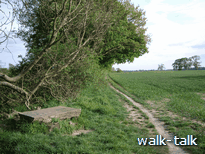
However, for maximum rhododendron viewing and a good long view, we go straight on in the direction we have been walking, keeping to the right of the line of trees.
Our path to the right of the line of trees
TL 134089
The golf course is on our
left.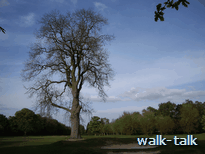 This point is very high and
the tree standing somewhat on its own on the course has been struck by lightning
more than once.
This point is very high and
the tree standing somewhat on its own on the course has been struck by lightning
more than once.
Tree struck by lightning – a high point.
TL 139089
Judging by the upwards lilt of its branches, I think that it is an ash. It has no foliage, either because it has been struck once too often or because this year we are in for a splash rather than a soak, the oak being well out before the ash.
Across to our right we see the poplars along the line of the Ver in the Gorhambury estate. They were planted at a time when their wood would have been valuable for making matches. Bryant and May were called in to advise on the planting. Unfortunately for the investors the bottom had fallen out of the match business by the time the trees came to maturity. Fortunate for all who pass this way – and along Redbourn Road – because I think the trees soften the landscape and add to its interest.
The path pathway curves markedly to the left.
Note the high bank up to the golf course. It looks
as if it has been terraced. However, the bank on the right is also high and we
are led to wonder if this used to be a drovers’ way.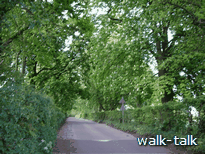
We come out on to the road through Batchwood and go left along it under the magnificent avenue of horse chestnuts.
The avenue through Batchwood
TL 136085
If you cannot bear to be on asphalt, go through the
hawthorn hedge on the right, but stay between the hedge and the line of trees to
be as clear as possible of golf balls being driven up the fairway on the right.
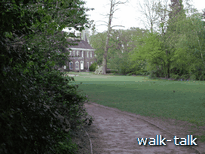
When we see Batchwood Hall we take the golfers’ path that curves right towards the Hall.
The golfers’ path that curves right towards the Hall
TL 136087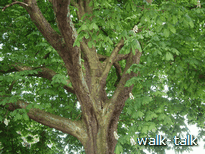
There are rhododendrons on the right, and then on the left, and then ahead.
We pass under a pair of beautiful horse chestnut trees
A horse chestnut tree by the Hall
TL 137088
 As
we come level with the corner of the Hall, we can see the road that takes us
right, back across the rear of the Hall to our car park,
As
we come level with the corner of the Hall, we can see the road that takes us
right, back across the rear of the Hall to our car park,
but perhaps with a pause for refreshment at the Leisure Centre.
The path to refreshments
TL137089
To print, click: short directions | map | full directions with map and photos | comments and info
home | books | treeblog | talks | walk of the month | walk directory | contact us